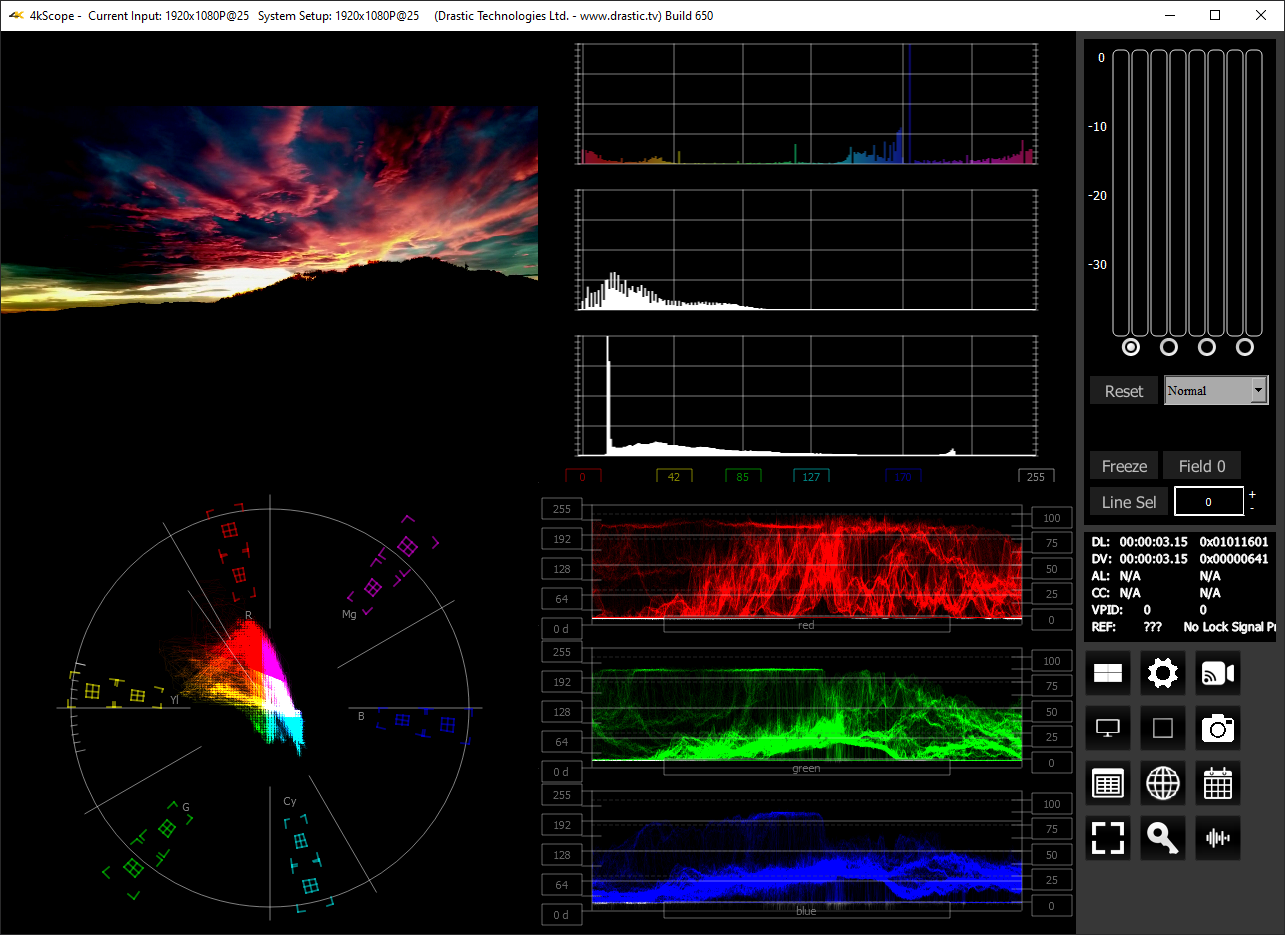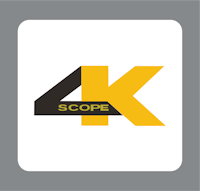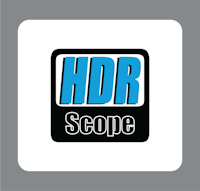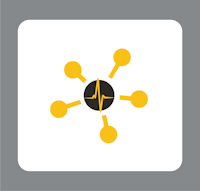 An overview of software based signal analysis monitoring for video
An overview of software based signal analysis monitoring for video
Software-Based Video Signal Analysis: An Overview

As the video production industry continues to grow and evolve, so do the tools and techniques used to ensure the quality and consistency of video content. As a result, software-based waveform vectorscope monitoring has become a more powerful and cost-effective option for video professionals. Drastic Technologies has leveraged their years of experiance to develop a comprehensive software based signal analysis solution.
What are Waveform Monitors, Vectorscopes, etc. and Why are they important for Signal Analysis?
Waveform monitors, vectorscope, chromaticity, and histograms are specialized tools used to measure and analyze various aspects of the color and luminance levels of a video signal. They display a graphical representation of the chroma and luma levels in a video signal, showing the hue, saturation, and luminance levels in relation to one another. By using this information, video professionals can ensure that the video they produce is within legal limits, with accurate color representation and proper luminance levels.
Audio waveform, histograms, and vectorscopes provide similar measurements for the audio portion of the signal.
Signal Analysis tools help video professionals maintain color consistency between shots and scenes, ensuring that the final video has a cohesive and polished look, and sound. They help to ensure that the video adheres to broadcast standards. Quantifying the signal can assist the user to correct color and luminance issues early in the production before they become a problem, saving both time and money.
Benefits of Software-Based Signal Analysis
Traditionally, video waveform vectorscope monitoring was performed using hardware-based equipment, such as a Leader or Tektroniks. However, with the advent of advanced software technologies, software-based video waveform vectorscope monitoring has become increasingly capable, and is far more affordable. There are several key benefits to using software-based solutions for video waveform vectorscope monitoring.
These benefits include:
-
Cost-effectiveness: Software-based vectorscope monitoring is significantly more affordable than traditional hardware-based monitoring, making it a more accessible option for small and medium-sized video production companies. Large companies can benefit too, using a hardware vectorscope for facility commissioning, then adding local software products for production teams.
-
Ease of Integration: With software-based monitoring, video professionals can work with the tools and software they are already familiar with, as opposed to having to invest in additional hardware and training. This makes the integration of vectorscope monitoring into the video production process smoother and more seamless.
-
Customization: Software-based vectorscope monitoring often offers a high degree of customization, allowing video professionals to configure and personalize their monitoring tools to meet their specific needs.
-
Portability: With software-based monitoring, video professionals can take their vectorscope monitoring tools with them wherever they go, as long as they have a computer and a signal.
How Does Software-Based Waveform Vectorscope Monitoring Work?
Software-based waveform vectorscope monitoring works by analyzing the color and luminance information within a video signal and presenting this information in a graphical form. This allows video professionals to easily see and understand the color and luminance levels within their video content, and make any necessary adjustments to ensure that the video adheres to industry standards and has a consistent look.
The software-based waveform vectorscope monitoring process typically involves three main steps:
-
Signal analysis: The software analyzes the video signal, breaking down the color and luminance information into its individual components.
-
Display: The software displays the analyzed information in a graphical form, typically in the form of a waveform or vectorscope display.
- Correction: The user takes note of any variance from best practice, and fixes it early in the production.
Importance of Proper Video Waveform Vectorscope Monitoring
Proper video waveform vectorscope monitoring is crucial for ensuring that video signals meet broadcast standards and provide high-quality images for viewers. Incorrect levels of luminance and chrominance can result in improper color balance and contrast, which can negatively impact the viewing experience. In addition, improper levels of luminance and chrominance can also lead to issues with transmission and reception of the video signal, which can result in loss of quality or failure of the signal to reach its intended destination.
Key Features of a High-Quality Video Waveform Vectorscope Monitoring Solution
When choosing a software-based video waveform vectorscope monitoring solution, it is important to consider the following key features:
-
Accuracy: The solution should provide accurate readings of the luminance and chrominance levels of the video signal. These should be understandable to the average operator, yet still useful to the engineer.
-
User-Friendliness: The solution should have a user-friendly interface that is intuitive and easy to use, allowing for quick and easy monitoring and analysis of the video signal.
-
Compatibility: The solution should be compatible with a wide range of devices and systems, allowing for easy integration into existing workflows.
Software-based Video Waveform Vectorscope Monitoring: The Key to Improved Quality Control
In the past, video waveform vectorscope monitoring was performed using dedicated hardware devices. These devices were bulky, expensive, and required specialized training to operate. With the advent of software-based video waveform vectorscope monitoring, however, the process has become much more accessible and affordable.
There are several key benefits to using software-based video waveform vectorscope monitoring in your video production workflow:
-
Increased Accuracy: Software-based video waveform vectorscope monitoring provides a more accurate representation of the video signal than traditional hardware-based monitoring. This is because software-based tools can be customized to meet the specific needs of each project, allowing for a more accurate measurement of the video signal.
-
Improved Flexibility: Software-based video waveform vectorscope monitoring is highly flexible and can be used in a variety of different production environments. Whether you are working on a large-scale production or a small indie film, you can use these tools to ensure that your video meets the desired technical standards.
-
Lower Cost: Software-based video waveform vectorscope monitoring is significantly less expensive than traditional hardware-based monitoring. This makes it an attractive option for independent filmmakers, small production companies, and others who are working with limited budgets.
-
Ease of Use: Software-based video waveform vectorscope monitoring is easy to use and does not require any specialized training. This makes it accessible to a wider range of professionals, including those who are just starting out in the video production field.
Drastic's Software Waveform/Vectorscope Solutions
 |
sdiScope is Drastic's most cost effective SD/HD signal monitoring tool. It provides all the core audio, video and data scopes, with support for CCIR-601 and Rec.709 color spaces. It is a basic version of the 4K/HDR/2110 Scopes, for standard monitoring needs. For advanced features like 4K, HDR, Ancillary, Loudness and event tracking, please check out 4K/HDR/2110 Scopes. |
|
 |
4KScope software provides real time, professional quality signal analysis for on set, production, post production, and research and development environments. 4KScope is designed to monitor from 4096x2160 down to NTSC/PAL and everything in between. 4KScope is perfect for Live/Post production, DIT pipelines, Broadcast monitoring, Signal QC and final HDR mastering workflows, including basic HDR/HLG/WCG monitoring and validating. For more advanced HDR, please check out our HDRScope. |
|
 |
HDRScope is the world's most powerful 8K through SD software signal monitoring tool and HDR image analyzer. It includes waveform (luma, YCbCr, RGB), vectorscope, histogram, chromaticity, and data/picture monitor for video. Audio histogram, phase, RMS, peak and loudness monitoring for up to 16 channels. HDRScope is designed to monitor from 8192x4320 down to NTSC/PAL and everything in between. |
|
 |
NetXScope software provides a real time, professional quality signal analysis tool for on set, production, post production, and research and development environments. NetXScope is designed to monitor SMPTE 2110, RTP, UDP, SRT, and RIST, and optionally, baseband video signals and TR-01. It supports SDR and HDR image analysis with support for 601, 709, 2020, HDR10 and WCG color spaces. |
|
 |
videoQC is a robust media player, with support for time code, closed captions, metadata, clipping and export, display modes, waveform/vectorscopes, and much more. Compare your media to a template or file, and perform full reference analysis. It's easy to make sure the content conforms to your specs with audio and video scopes, wide file format support, and CSV/SQLite, HTML, and PDF reports. |
Trademarks, Registered Trademarks, and CopyrightsTrademarks, Registered Trademarks, and Copyrights
All other trademarks are the property of their respective owners.

